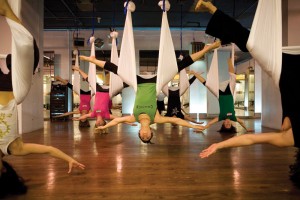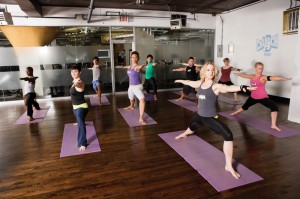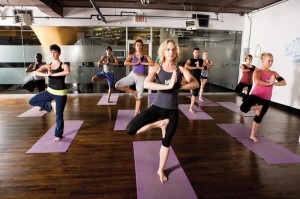 People want to lead a harmonious, well-balanced life. The addition of Pilates and yoga classes to clubs has given members the opportunity to incorporate these exercises into their lives and achieve a balanced life.
People want to lead a harmonious, well-balanced life. The addition of Pilates and yoga classes to clubs has given members the opportunity to incorporate these exercises into their lives and achieve a balanced life.
In coordination with these classes come unique stereotypes — they are for the elite, the hippies or just for women. Regardless of the false stereotypes, what does it really take to include yoga and Pilates classes in your gym?
Not Just the Basics Anymore
Basic yoga and Pilates classes are no longer the only options available for members. Yoga and Pilates have evolved and have been combined with other equipment and techniques to have a broader appeal to members.
“On a monthly basis we offer specialty classes like Iron Man Yoga (yoga with weights), Yoga for Athletes, Yoga for Runners, Restorative Yoga, Mommy and Me Yoga-lates and Partner Yoga,” said Jacki Dalsimer, the fitness director for the Canton Club in Baltimore, Md. “In addition, we have a program called Air Yoga, which is yoga using the support of hammocks suspended from the ceiling.” This is in addition to Canton’s standard yoga and Pilates classes.
“We offer a very wide range of programming,” said Donna Cyrus, the senior vice president of programming at Crunch Fitness. “We offer traditional yoga and then we offer a lot of fusion based programming that delivers our members more flexibility than spending an hour and a half doing traditional yoga.” Crunch offers a “Yoga Ride” class that combines spinning and a 30-minute yoga cool down that has been very successful, Cyrus said. Other options have included core yoga, hippy yoga (focuses on hips) and virgin yoga for beginners. As well as fat burning Pilates, hot Pilates and more.
Many members may not realize the multitude of benefits from yoga or Pilates. “Through regular practice of yoga poses and postures, as well as Pilates strengthening and stretching exercise, members are able to obtain a wide range of health benefits,” Dalsimer said. According to her, benefits include: the lengthening of muscles, creating fluidity and ease of movement, creating muscle mass, physical power, and endurance, increased balance, improved posture through spinal alignment, improved respiration, circulation and cellular regeneration, improved core strength, mental clarity and better stress management.
Cyrus said, the vast majority of members have lower back and hip issues from sitting all day at their jobs, which can make runners and spinners more prone to injury. Yoga and Pilates can be a great way to strengthen these muscles, open up hip flexors and prevent injury.
 Marketing Yoga and Pilates Programs
Marketing Yoga and Pilates Programs
Marketing the outstanding benefits to your members will help them fall in love with these wellness classes. Lori Lowell, a Gold’s Gym franchisee affiliated with eight clubs, encourages attendance for their mind-body classes during Group Fitness Orientation classes that are offered to new members, as well as through trial and introduction classes, direct mail and member appreciation classes.
“We try to encourage all members to engage in a mind-body type class for variety in their workout,” Lowell said. “We always try to get our members to take Body Flow first. It’s a great way to introduce ‘fitness-minded’ members into a fusion class.” “It is a comfortable type of class for new mind-body participants, but is also a wonderful class for seasoned mind-body class takers.” Once a comfort level is reached, it’s easier for members to try different things.
To better market to members, facilities should begin by determining a target market and develop its brand, said Carol Trioche, the vice president, Full Solutions™ at Merrithew Health & Fitness™. “STOTT PILATES® (a premiere brand of Merrithew Health & Fitness) Certified Instructors always have access to marketing support from our Marketing and Communications team,” she said. STOTT PILATES can also help implement Pilates programs for clubs by assisting with training, hiring, assessing needs, marketing and branding support.
Integrating yoga and Pilates with other modalities will help break any stereotypes members have about the two types of cultures and alleviate any anxiety about trying something new. Crunch Fitness integrates yoga and Pilates classes into programming to target a specific group — like for athletes there could be “Jock Yoga” or include yoga or Pilates as part of a golf or tennis package. “It brings awareness and they get a little taste of it without having to fully commit,” Cryus said.
“Basically we reel them in and hook them!” Dalsimer said. “Our monthly programs target people who would not normally take yoga. For example, yoga for runners targets those who just want to do cardio and run on the treadmill. Once they experience the benefits of yoga and see how it helps improve their running, they transition into regular class goers.
“Our Extreme Personal Fitness (XPF™) Programs incorporate yoga/Pilates in the program. Participants are encouraged to then participate in regular yoga/Pilates classes to be able to develop the core strength and improve balance.”
There are also those members that already love yoga and Pilates, and typically enjoy either, in their more basic classes. “We cater to ‘Yogis’ (a practitioner of yoga) too,” Cyrus said. “They typically have a freer lifestyle, for whatever reason, and we make sure we have classes convenient for them too. They’re looking for the traditional classes.”
Running a Successful Program
Having a well-run yoga and Pilates program is extremely important to the life of these classes. Lowell suggested having a separate director that runs the Pilates and yoga portion of programming. “Running a yoga/Pilates department requires a director that is well versed in the programming aspects that are specific to these types of programs,” Lowell said. “Also, fee-based Pilates and the Pilates Reformer program takes a special effort and focus — it moves into the sales aspect of programming that many Group Fitness directors do not specialize in.”
 For Cyrus, it helps to umbrella Pilates Reformer, a class taught utilizing the standard Pilates resistance machine called a reformer, under the personal training department so that the program can be marketed as an option like personal training, since both are added costs.
For Cyrus, it helps to umbrella Pilates Reformer, a class taught utilizing the standard Pilates resistance machine called a reformer, under the personal training department so that the program can be marketed as an option like personal training, since both are added costs.
Having instructors with strong certification backgrounds is important, they not only have a better understanding of working with the body, but they can also teach a variety of classes, Cyrus said. Dalsimer agreed, “People need to know the quality of the class and that the instructor is on par with those at private yoga/Pilates studios.”
In terms of equipment that’s needed, it depends on what kind of classes your club offers. Standard equipment includes mats, bands and blocks. Dalsimer suggested adding Reformers, Bosu balls or hammocks to amp up programming — Canton Club utilizes hammocks with their Air Yoga classes making it a unique opportunity.
Members also expect a relaxing space for these classes. Cyrus pointed out that real estate is difficult — especially in Manhattan — so separate yoga and Pilates studios don’t always make sense. She suggested trying to find ways to change the ambiance of a Group X room when it is used for yoga by installing light dimmers, adding curtains or using battery operated candles, and having two different sets of mats, one for regular programming and one for yoga. “Wellness-based people want the feeling of those classes being a separate thing,” she said.
Clubs themselves benefit from offering yoga and Pilates classes, they retain members who otherwise might seek out private studios to get their wellness fix. “Incorporating these programs show the gym is dedicated to wellness and well-rounded fitness programs,” Dalsimer said.
Paid classes also bring in extra revenue for clubs. Lowell only charges members extra for equipment classes, the rest are included in their membership. The Canton Club positions their paid classes as specialized training, like Air Yoga, and refer to them as “trainings,” not classes. The level of instruction needs to be higher and the number of participants is limited to provide personal attention for participants in these trainings.
Successful marketing of yoga and Pilates classes, and informing members about the wide range of benefits these modalities offer, will guarantee that they see a use for these classes in their everyday lives.
Yoga and Pilates have become more mainstream in recent years. Positioning them as a “mainstream” class will continue to break down stereotypes people associate with these types of classes and help you gain and retain members. -CS
By Ali Cicerchi








